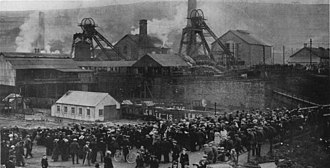Our website is made possible by displaying online advertisements to our visitors.
Please consider supporting us by disabling your ad blocker.
Senghenydd colliery disaster

The Senghenydd colliery disaster, also known as the Senghenydd explosion (Welsh: Tanchwa Senghennydd), occurred at the Universal Colliery in Senghenydd, near Caerphilly, Glamorgan, Wales, on 14 October 1913. The explosion, which killed 439 miners and a rescuer, is the worst mining accident in the United Kingdom. Universal Colliery, on the South Wales Coalfield, extracted steam coal, which was much in demand. Some of the region's coal seams contained high quantities of firedamp, a highly explosive gas consisting of methane and hydrogen.
In an earlier disaster in May 1901, three underground explosions at the colliery killed 81 miners. The inquest established that the colliery had high levels of airborne coal dust, which would have exacerbated the explosion and carried it further into the mine workings. The cause of the 1913 explosion is unknown, but the subsequent inquiry thought the most likely cause was a spark from underground signalling equipment that could have ignited any firedamp present. The miners in the east side of the workings were evacuated, but the men in the western section bore the brunt of the explosion, fire and afterdamp—a poisonous mixture of carbon dioxide, carbon monoxide and nitrogen left after an explosion.
Fires in the workings hampered rescue efforts, and it took several days before they were under control. It took several weeks for most of the bodies to be recovered. The subsequent enquiry pointed to errors made by the company and its management leading to charges of negligence against Edward Shaw, the colliery manager, and the owners. Shaw was fined £24 while the company was fined £10; newspapers calculated the cost of each miner lost was just 1 shilling 1+1⁄4d (about equivalent to £7 in 2023).
In 1981 a memorial to the men who died in the disaster was unveiled by the National Coal Board, followed by a second in 2006, to honour the dead of both the 1901 and 1913 explosions. In October 2013, on the centenary of the tragedy, a Welsh national memorial to those killed in all Wales's mining disasters was unveiled at the former pithead, depicting a rescue worker coming to the aid of one of the survivors of the explosion.
Previous Page Next Page


